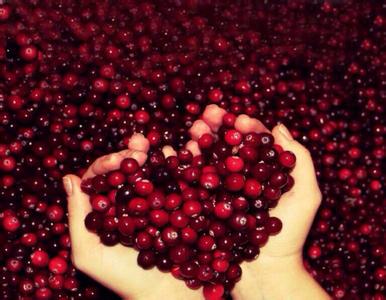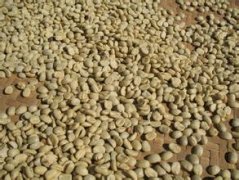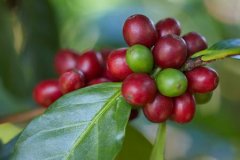Brief introduction of coffee from eight major producing areas in Guatemala: Vera Coffee the producing area of Guatemalan Coffee

5. FraijanesPlateau ®:
The area is of volcanic soil, with high altitude, sufficient rainfall and great humidity variation. Ash from Pacaya, Guatemala's most active volcano, provides important minerals for the soil in the region. There is plenty of sunshine in the dry season, and although the clouds and dew are heavy in the morning, they dissipate quickly. As a result, 100% of the coffee in the area is processed in the full sun.
FraijanesPlateau ®cupprofile of coffee cups in Waiqiangsi Plateau
The acidity is bright and consistent, the aroma is full, and the mellow thickness is delicate.
6. HighlandHuehue ®:
Of the three major non-volcanic coffee producing areas in Guatemala, the Mini Tenango Highlands has the driest climate and the highest elevation. The dry and hot wind from Mexico's Tehuantepec plateau protects the region's coffee from frost and can be grown to 2000 meters (6500 feet). Because of its remote location, all coffee farmers have to process their own coffee, but fortunately there are so many streams in the area that small processing plants can be set up almost anywhere.
The HighlandHuehue ®cupprofile of Mini Tenanguo Highland Coffee Cup:
High acidity, pleasant, mellow thickness, with wine aftertaste.
7. New Oriental (NewOriente ®):
Coffee in this area has been grown entirely by small farmers since the 1950s, and now every farmer in the mountains is a coffee production unit. This area, once the most remote and poorest part of Guatemala, is now alive and well. Rainy, cloudy, New Oriental ancient times is a volcanic area, soil volcanic metamorphic rock evolved, rich in minerals, balanced nutrition, different from other volcanic coffee producing areas.
New Oriental coffee cup test features (NewOriente ®cupprofile):
The palate is well-balanced, mellow and full-bodied, with chocolate flavor.
8. Mount San Marco VolcanicSanMarcos ®:
San Marco has the hottest climate of the eight largest coffee producing regions in Guatemala, with a maximum rainfall of 200inches (5000 mm). The rainy season is earlier than in other areas, and coffee trees bloom earlier. Like other remote areas of Guatemala, volcanic San Marco coffee is grown and processed by small farmers. Due to frequent rainfall in the rainy season, most coffees are pre-dried in the sun and then dried in a Guardiola dryer.
VolcanicSanMarcos ®cupprofile of the volcano San Marco coffee cup
There are subtle floral aromas in the aroma and taste, obvious acidity and good mellow thickness.
Guatemala is a famous producer of high-quality Arabica coffee in Central America. Coffee from five volcanic and three non-volcanic producing areas is very unique and enjoys a high reputation in the international market.
Mr. EduardoAmbrocio of the Guatemalan Coffee Company introduced Guatemalan coffee to the audience at the SCAA Houston show in April 2010.
1. AcatenangoValley ®:
The AcatenangoValley Valley, which is 2000 meters (6500 feet) above sea level, is shaded and ecologically unique, and the nearby Fuego volcano continues to erupt, making its coarse, sandy soil rich in a variety of minerals. Temperate sea breezes from the Pacific and a seasonal climate allow coffee in this region to be dried by sunlight and processed according to traditional family methods that have been accumulated over the years.
AcatenangoValley ®cupprofile for coffee cups in the Alcatrago Valley:
The acidity is obvious, the dry and wet fragrance is remarkable and pleasant, the alcohol thickness is good, and the aftertaste is clear and long.
[note] Frag/Aroma: aroma / aroma Flavor: flavor Acidity: acidity Balance: equilibrium
Body: alcohol thickness Aftertaste: aftertaste (aftertaste) Overall: overall (impression)
two。 Antigua coffee (AntiguaCoffee ®):
Rich volcanic soil, low humidity, plenty of sunshine and cool nights are the climatic characteristics of Antigua coffee producing areas. The valley is surrounded by three volcanoes: Agua, Fuego and Acatenango. Tierra del Fuego volcano is one of the three most active volcanoes in Guatemala, and the ash from frequent eruptions makes the soil of Antigua rich in minerals. The volcanic pumice in the soil can maintain humidity and help overcome the lack of rainfall in Antigua. In addition, the tree shade in this area is particularly dense, which can withstand occasional frosts and protect coffee plants from frosts.
AntiguaCoffee ®cupprofile (Antigua coffee cup)
Rich wet fragrance, good balance, high sweetness, elegant taste.
3. Traditional Attilan (TraditionalAtitl á n ®)
Atitlan is one of the five largest volcanic coffee producing areas in Guatemala, and its soil organic matter is the most abundant among the five volcanic coffee producing areas. 90% of the traditional Atilan coffee is grown on the violent volcanic slopes of Lake Attila, where the daily breeze stirs the lake, which is an important factor affecting the microclimate of the region. The area has accumulated excellent planting and processing techniques for a long time.
Traditional Attilan coffee cup test feature (TraditionalAtitl á n ®cupprofile):
The aroma is refreshing, the acidity is bright and the mellow thickness is full.
4. Rainforest Coban (RainforestCoban á n ®)
Koban is cloudy, rainy and cool all the year round. The vast majority of Koban coffee in the rainforest is grown in the obviously undulating and foggy mountains of the region and is deeply influenced by limestone and clay in the Atlantic basin. Koban has two seasons: the rainy season and the rainy season.
Measurement characteristics of Coban Cup in Rainforest (RainforestCb á n ®cupprofile)
Obvious fresh fruit flavor, balanced mellow thickness, pleasant aroma.
Important Notice :
前街咖啡 FrontStreet Coffee has moved to new addredd:
FrontStreet Coffee Address: 315,Donghua East Road,GuangZhou
Tel:020 38364473
- Prev

A brief introduction to the boutique coffee manor; Antigua coffee in Guatemala has a taste of fragrance.
Drinking pure Antigua coffee from Guatemala and playing a South American folk song. Our thoughts can be pulled far away, as far as we have never met before. The wise Mayans who once existed in the land of Guatemala, after a day's work under a coffee tree we have never seen before, they enjoyed authentic Guatemalan coffee after dinner and watched the sunset.
- Next

Brief introduction of Fine Coffee in Guatemala: origin, Development, History and Culture of Coffee in Guatemala
3. The coffee producing region of Guatemala is bordered by Mexico to the north, Honduras and El Salvador to the south, the Caribbean to the east and the Pacific Ocean to the west, with tropical rain forests, volcanic geology, plateau valleys and changeable microclimate. Guatemalan coffee once enjoyed a reputation as the best quality coffee in the world. The extra hard coffee beans here are full-grained, delicious and balanced.
Related
- Does Rose Summer choose Blue, Green or Red? Detailed explanation of Rose Summer Coffee plots and Classification in Panamanian Jade Manor
- What is the difference between the origin, producing area, processing plant, cooperative and manor of coffee beans?
- How fine does the espresso powder fit? how to grind the espresso?
- Sca coffee roasting degree color card coffee roasting degree 8 roasting color values what do you mean?
- The practice of lattes: how to make lattes at home
- Introduction to Indonesian Fine Coffee beans-- Java Coffee producing area of Indonesian Arabica Coffee
- How much will the flavor of light and medium roasted rose summer be expressed? What baking level is rose summer suitable for?
- Introduction to the characteristics of washing, sun-drying or wet-planing coffee commonly used in Mantenin, Indonesia
- Price characteristics of Arabica Coffee Bean Starbucks introduction to Manning Coffee Bean Taste producing area Variety Manor
- What is the authentic Yega flavor? What are the flavor characteristics of the really excellent Yejasuffi coffee beans?

